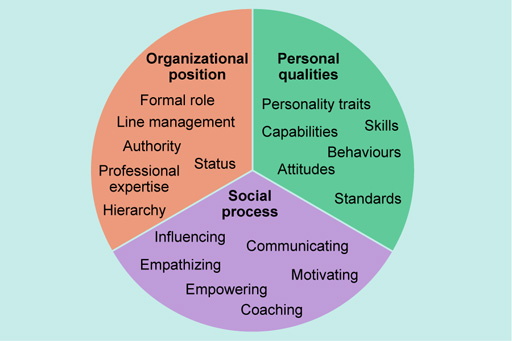1.2.2 Three approaches to leadership
Figure 4 has been developed from ideas in the book Leadership for Healthcare (Hartley and Benington, 2010). In the book, the authors explain first of all that there is no widely accepted simple definition of leadership in healthcare or in wider public services. Rather, various writers have offered different definitions, each tending to focus on a different aspect of leadership.
These ‘perspectives’ on leadership involve:
- the personal qualities of leaders
- leadership as a position (within an organisation)
- leadership as a social process.
The diagram contains key words that are associated with each perspective. If you’ve read any books or articles, or listened to any speaker on the subject of leadership, these perspectives could help you understand which of these perspectives the writer or speaker is talking about. In their book, Hartley and Benington argue that each of the three perspectives has insights to offer about how to lead effectively, while also raising further questions. You will investigate some of these questions in more detail later this week.
To begin with, listed below are some initial questions to help you think about what the three perspectives might mean for the context you work in. You’ll probably find some of them more meaningful than others, depending on your particular experiences and work situation. The questions are listed for each perspective. You may want to make a note of your answers so that you can refer back to them later.
Personal Qualities
Can you identify particular personal qualities that you think it is important for a leader to have? In your experience, do these qualities depend on the context of the team or work that is to be led? Which ones do you think are particularly important in your current team or context?
Leadership as a position
In any organisation, there are particular formal positions that offer the authority to exercise leadership and direct or persuade others (e.g. a sergeant, a matron, a chief executive). However, while a position confers the opportunity to exercise leadership and creates accountability, some people in those roles do not seem very ‘leaderful’ – they are not able to give a sense of purpose or to influence people to the purpose. On the other hand, there may be people who are influential leaders who do not hold a particular position (e.g. the opinion leader in a professional team, the agitator).
Leadership as a social process
Leaders who direct the kinds of discussion, persuasion, network building, negotiation and consensus building that go on in an organisation could be said to be exercising leadership through social process. Social process is also about the relationships with those being mobilised – for example, if people don’t accept a leader, then they can make life difficult for that person. The kind of leader they expect (in their heads) affects the effectiveness of a leader.

